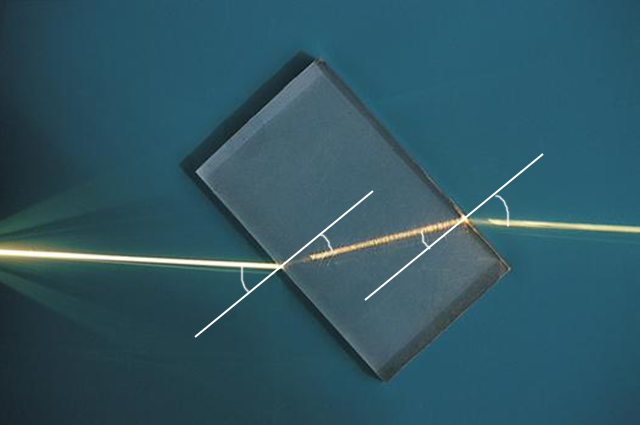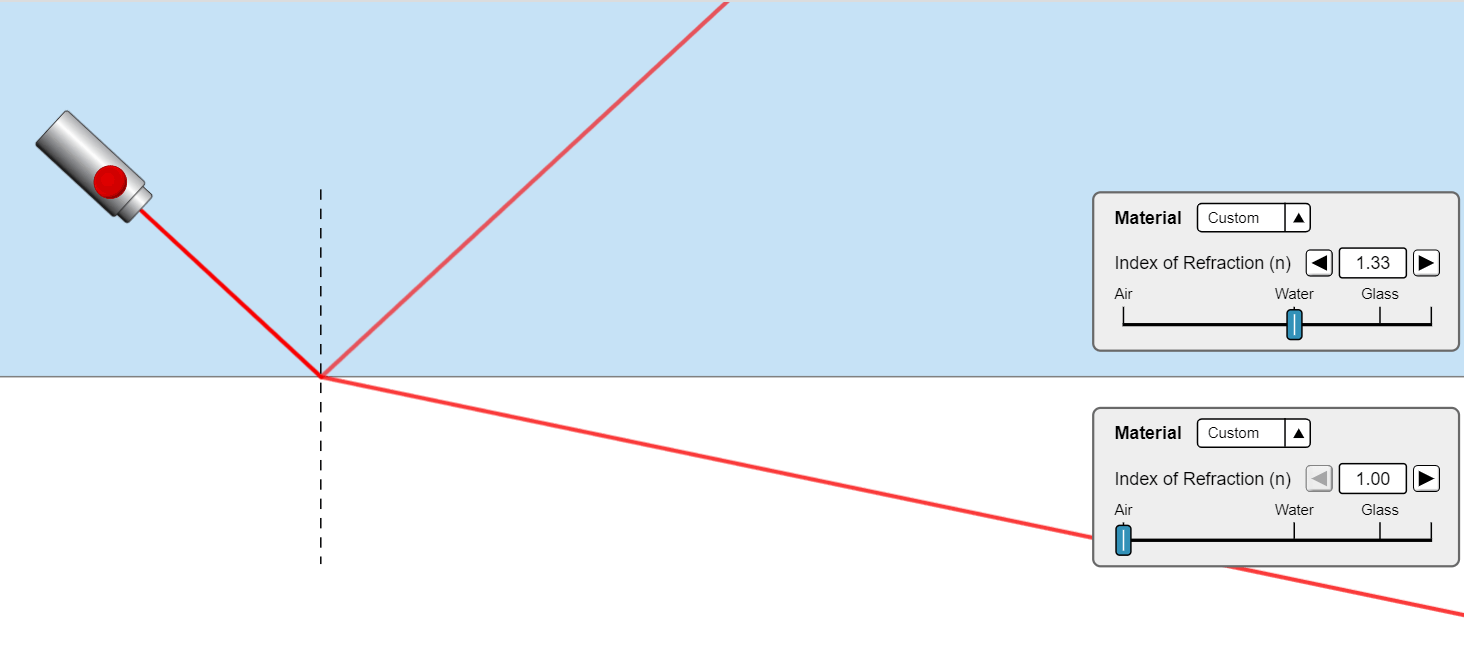Physics > Waves > Refraction: IGCSE theory
Refraction is the bending of light rays that happen when light travel from one material into another
The bending of light rays occurs, at the interface between two different materials, if the light travels at different speeds in each of them. That can be understood in terms of the principle of least time, which is not in the IGCSE syllabus but you can check it out if you are curious.
A familiar sight that is a consequence of refraction is the bending of a pencil placed in a glass with water.
The bending of light rays is an angle measured from the normal, which is a line perpendicular to the surface (more details about the normal in the Brief geometry and trigonometry revision). The image below shows the incident and refracted angles measured with respect to the normal:

refraction of light when crossing a glass block .Credit : Wikipedia (image adapted by REO)
On the image above is possible to see the light bend towards the normal when it enters glass and bends away from the normal when it exits. This trajectory is observed either way the light comes.
The IGCSE paper will pose questions about the angles involved, which are given by Snell´s Law. The version of Snell´s law used in IGCSE is shown below. I must inform that this is formula only applies for the situation in which light is coming from air (or vacuum) so that is a simplification. If you research books and websites you will find the complete version of the law, that works for light coming from any medium. I discuss this situation here. All the IGCSE calculations can be done by the simplified formula, but it is worth to know the complete formula, as I argue here.
The formula for refraction involves a number called the refractive index, which is characteristic of each material;
Refractive index (n)
It is related to how fast light can travel inside the ,material. Light is fastest in vacuum. As you add particles to the medium, it slows down. In air the speed is only slightly lower and it is usually the same as in vacuum. The refractive index (n) is given by the formula:
n = speed of light in a vacuum / speed of light in the material
The value of n for some materials is given below:
| material | n | material | n |
| Vacuum | 1 | Crown Glass | 1.52 |
| Air | 1.0003 | Salt | 1.54 |
| Water | 1.33 | Asphalt | 1.635 |
| Ethyl Alcohol | 1.36 | Heavy Flint Glass | 1.65 |
| Fused Quartz | 1.4585 | Diamond | 2.42 |
| Whale Oil | 1.460 | Lead | 2.6 |
Numbers from the CRC Handbook of Chemistry and Physics
Observe that diamond has the highest value and that is why it is such a bright material. That will be explained below.
Snell´s law for refraction
Now I can show the formula for refraction (simplified Snell´s law)

i is the angle measured for the incident light and r represents the refracted angle (after light entered the new medium).
Before we start to do some calculations , let me introduce the last concept needed for IGCSE refraction that is total internal reflection (TIR):
total internal reflection (TIR)
When an incident light ray hits a glass surface, for instance, part of the light is refracted (into the material) and part is reflected. This is observed when we look at windows. If you look at the window during the day you observe mainly the light coming from the outside. When you do it at night, with the lights on inside, we see a lot of reflected light and less of the outside light. This is related to the intensities of the lights inside and outside.
But the intensity of light reflected also depends on the angle of incidence of light. The image below (extracted from the refraction PHET simulation shows an incident light ray being partially reflected and partially refracted. If the incident angle increases further then the refracted angle disappears and all the light is reflected. This is TIR,, as explained in my video which is also based on this same simulation.

reflection and refraction of a light ray. Image extracted from PHET animation
The smallest angles at which TIR occurs is called the critical angle and it is given by the formula:

This formula assumes that the second medium is air or vacuum (n=1). The value of n that enters this formula is the one of the medium from where light is coming.
